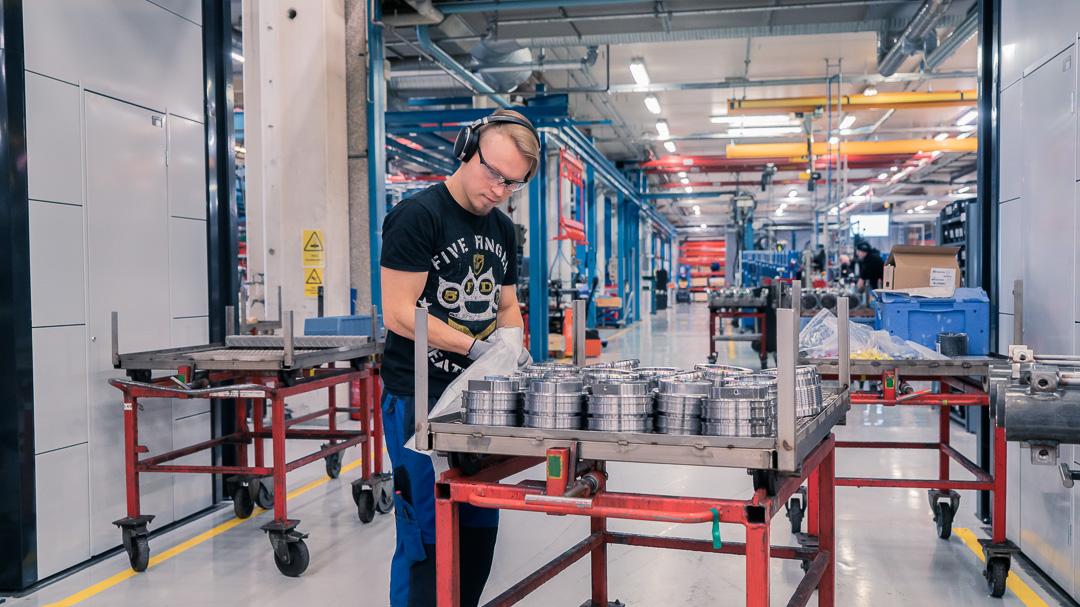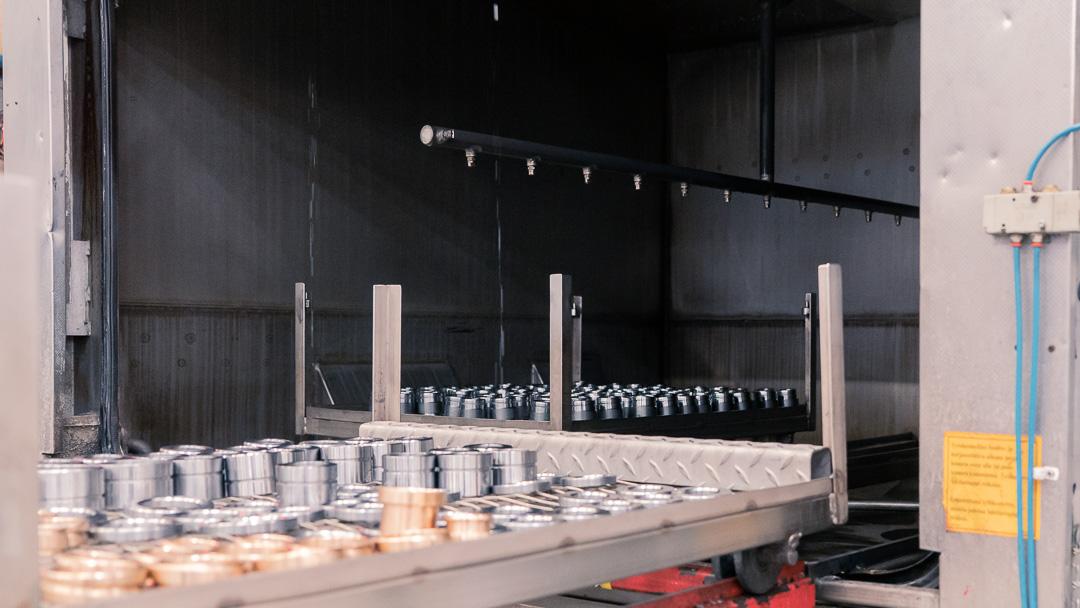Understanding ISO codes in hydraulics
While working in the hydropower industry, most probably you have stumbled upon the term ISO 4406? What the code is referring to is ISO 4406:1999 standard for oil cleanliness. In 1999, The International Organization for Standardization developed a system ISO 4406:1999. This system rate and quantify the number of particulate contamination levels per milliliter of fluid at three sizes; larger than 4-, 6-, and 14 microns.
The ISO code is expressed in three numbers, for example, 18/16/13. Each number typifies a contaminant level code for the correlating particle size. When the code increases, the quantity range of particles doubles.
Originally this ISO standard was designed for hydraulic oils to determine if the oil was clean enough to pass through small components and tubes in valves, controllers, and actuators. Today the ISO code includes gear oils, engine oils, and various other industrial oils.
The smaller the number is, the cleaner the oil. All the 6- and 14-micron particles are counted in the 4-micron section, and the 14-micron particles in the 6-micron section. In comparison, the human hair diameter is around 70-microns, so you can imagine how small these particles are.
The ISO 4406 Cleanliness Codes are national standards that provide cleanliness in vehicles, equipment, and machinery. Let’s have a closer look at what ISO 4406 cleanliness means and how to measure it and maintain cleanliness.
Understanding ISO cleanliness codes
ISO Cleanliness Code is a three-digit value used to communicate particulate contamination in the oil. The code is a global standard used to report and count the particles in a 1 ml sample measured by laser, and the test result is declared in three-digits. The first number represents the total quantity of particles >4 microns, the second >6 microns, and the third >14 microns.
The table below is a typical representation of ISO cleanliness codes. Notice as the ISO code number increases by one, the quantity range doubles. In other words, an ISO code of 11 communicates a range of particles between 10 to 20 in number. An ISO code of 12 expresses a range of particles of 20 to 40 in number.
What may be confusing about ISO codes is that the ISO code number corresponds to a range, not a volume of fluid contamination particles. The critical thing to remember is that every 1 point increase in ISO code doubles the contamination volume range. If you take code 18 and jump to a code 19, you jump from a contaminate range of 1,300-2,500 particles per milliliter (p/ml) to a range of 2,500-5,000 p/ml.
ISO 4406 Contamination codes
Number of particles per 100 milliliters

ISO 4406 Code. Cleanliness levels are defined by three-digits divided by slashes (/). These numbers correspond to 4-, 6-, and 14-microns. Each number refers to an ISO code determined by the number of particles for that size (4 µm, 6 µm, and 14 µm) and larger present in 1 ml of fluid. The range of fluid is double the range below in the chart. This chart indicates the actual ranges.
The human eye can only see particles sized down to 40 microns.
 |  |
Why is ISO 4406 cleanliness important?
It is vital to use the correct oil and ensure that cleanliness to the targeted level is achieved successfully. The aggressive management of oil contamination performs significant changes in component service life. Most often, the amount of particle contamination in the oil is the most influential factor determining how long a fluid component will last.
Many maintenance professionals don’t realize that they have a problem with fluid-related failures because they don’t correctly characterize the failures or the root cause. The fact is that 60-80% of failures for mechanical equipment are typically fluid-related. The standard way most machines fail is to wear out. Therefore, it stands to reason that when particle contamination reduces, wear rates go down, and component service life goes up.
The most critical quality of hydraulic fluid is cleanliness. When we talk about cleanliness, we refer to the size and quantity of solid particle contamination. The primary function of ISO standards is to measure and express the quality of oil cleanliness.
Although the benchmark for oil cleanliness has changed over the years, everyone seems to agree on the test method and fluid contamination levels. As astonishing as it is, this standard is world-wide and used in various fluid power industries.
It’s vital to maintain your hydraulic systems and fluid systems at a high cleanliness standard. Having an efficient filtration system is a critical factor in keeping cleanliness standards. Contaminated oil can block filters, reduce the engine’s airflow and needlessly increase wear and tear on engine components. To ensure your machinery’s fluid systems are maintained to ISO Fluid Cleanliness Standards, finding quality oil storage and filtration systems is essential.
Studies show that particle contamination in the oil causes approximately 80 % of mechanical wear.
What does ISO 4406 cleanliness mean?
An ISO Cleanliness code is a great invention, but why do these numbers matter? Does it seem like a lot for contaminants that surely should be visible in the oil? The reality is that we can’t see the 4-, 6-, and 14-micron particles with the naked eye.
Until the particles get as large as 40-50 microns, we can see them without a microscope. The human eye can see objects bigger than 40-μm.
For example, a red blood cell is around 8-microns. By comparison, the red-blood cell-sized particles are compromising the life expectancy of your equipment. By the time you can see the contaminants in your oil, the oil cleanliness is compromised. Effectively it means your oil isn’t meeting the ISO standards and is contaminated.
Effective contamination control requires a good strategy. Implementing a contamination control strategy may require a lot of time and effort. The reward, though, is worth it by the long-term results. Developing an effective contamination process can be created in four simple steps:
- Set appropriate ISO targets for cleanliness
- Take necessary actions to reach the target
- Use ISO particle measurements to ensure compliance
- Establish a monitoring and maintenance system that reflects the ISO compliance
Hydraulic component clearances are critical and require strategic filtration designs to remove the sized particles that will attack the hydraulic system’s most vital components.
How clean should the oil be?
How do you know to determine the cleanliness of hydraulic oil? The first step is to identify the target fluid cleanliness goal for your fluid power system. Set the target based on equipment type, sensitivity to contamination caused failures, operating environment, and critical aspects.
The more sensitive a component is for contamination, the cleaner the oil and the hydraulic system should be. The more critical a system is from a production, safety, or environmental standpoint, the cleaner it should be.
System pressure also affects, as pressures increase, tolerances typically decrease, making higher pressure hydraulic systems more sensitive to contamination failures than lower pressure systems.
Common Industry ISO Cleanliness Ratings

ISO 22/21/18 – Common cleanliness level of fluid
ISO 18/16/13 – Target rating for heavy gear/engine oils
ISO 16/14/11 – Target rating for hydraulic/transmission oils
ISO 14/13/11 – Target rating for diesel fuel
Setting targets for ISO cleanliness in hydraulics
When setting targets for your hydraulic systems’ ISO cleanliness codes, it is essential to keep in mind the objectives. It’s vital to maximize the equipment’s reliability and safety, minimize repair and replacement costs. This aids in extending fluid lifetime, respect warranty requirements, and reduce production downtime. Once you set the target ISO cleanliness code, you should follow the process to achieve the target, monitor, and maintain it. The systematic approach provides you with many rewards.
When setting goals for the oil cleanliness program, it’s essential to consider several factors. The first step is to identify the most sensitive components in your system, which creates the targets for system cleanliness. If a central pool provides several methods, maintaining the overall cleanliness is a must. Sufficient filtration protects the most sensitive components and cleans the fluid before reaching that target component.
While every situation is different, try to aim for ISO code ranges around 12-17 for the first codes, 10-14 for the second codes, and 8-13 for the third codes after the cleanliness process. In hydraulic systems, several components rely on a single source of fluid. It is essential to know all components’ cleanliness requirements to meet the most sensitive component’s ISO requirement.
How to measure the ISO cleanliness code?
The two most common methods of calculating the ISO cleanliness codes are the laser particle counter and the vacuum patch test. You can directly connect an online laser particle counter to the hydraulic system through sample ports. The online system provides the most accurate cleanliness analysis. It gives you the exact ISO count with minimal effort.
At Hydroline, we use the PAMAS S50 -online measuring devices due to cost-effective properties and high-performance values. The laser-based online systems offer simple integrations into industrial data management systems.
Another testing method is the vacuum patch test kits which include particle sample images at various ISO codes. The ISO-rated contamination source microscope visually matches your patch to the closest ISO-rated sample. This test requires more effort and is more indistinct than the laser particle counter. The benefit of the vacuum patch kit is that it can help you identify the contamination source based on the material viewed via the microscope.
How can you achieve the ISO 4406 cleanliness codes?
When thinking about a fluid system, the tendency is to think only about the system components. Typical oil handling methods will have a significant impact on the amount of contamination in equipment. Due to this, a part of a holistic contamination control strategy is a must. Most systems require revision, upgrade in fluid equipment, storage, and handling.
The whole process of preventing contamination in fluid systems starts with new oil. New oil from bulk deliveries usually contains 2 to 20 times the amount of particles acceptable for most fluid equipment. The cleanliness of fresh oil isn’t an indictment of suppliers but necessary for reaching the cleanliness targets.
Again, fixtures are excellent practice to maintain new oil’s cleanliness at least two ISO codes cleaner than the in-service oil targets. It allows modest amounts of contamination in the application during the transfer while still meeting the targets. The concept that states – a new oil isn’t a clean oil – may be shocking. It’s crucial to consider the number of times a fluid you transfer before putting it into the system.
Preventative actions | As part of pro preventative actions in the cleanliness program, it is essential to stop airborne contaminants from entering the hydraulic system. It is one of the most distinct problems to address through high-quality desiccant breathers that strip particles and moisture from the air. Whenever there’s an air exchange, either due to volume changes or thermal siphoning, use desiccant breathers, including bulk and tote storage tanks, drums, and transfer containers. And all critical in-service equipment. |
Filtering bulk storage | Preventing contamination in fluid systems starts with new oil from bulk deliveries. As mentioned earlier, the new oil isn’t clean. The first step in ensuring the new oil’s cleanliness is to filter the oil to an acceptable level. Using the most effective technique in filtering the new oil patch depends on the bulk delivery method. If it comes in barrels, each barrel can be filtered using portable compact filtration units. If the volume is more extensive, filter the oil during the transferring process. Another popular technique is to use a comprehensive fluid management system. Configure the fluid management systems with various options: separate pumps and filters for each fluid, high-quality desiccant breathers, fittings, stoppers, and even flow meters to measure and track the amount of oil dispensed. Whether you filter oil in the barrel before use or distribute using transfer containers, it’s essential to realize that all new oils should be pre-filtered at least five times before using it in the hydraulic systems. |
Storage | Storage containers often refer to cabinets located throughout the facility to store fluids. These cabinets store a variety of containers utilized to transfer oils from bulk storage to the component itself. Keep the storage cabinets closed when not accessed, cleaned, or orderly to avoid contamination. They should have a place designated for any fluids or tools stored in them. |
Oil transfer containers | The oil transfer containers should be sealable, marked by a product type, color-coded, made of plastic. Easy regular cleaning should be a vital part of the cleanliness process. Ideally, transfer containers should come with quick connections to fill them without exposing the container to the outside environment, and sealing the containers always when not in use is necessary. When possible, avoid funnels and separate handling equipment maintained for different lubricants. |
Component modification | It’s necessary to maintain the appropriate modification of components that allow routine lubrication tasks without opening the oil reservoir. These modifications include visual oil condition and level checks, oil sampling, oil top-offs, and even an oil change. |
Oil transfer | Once you have addressed all the physical points of ingression, it is necessary to manage the personnel charged with maintaining the fluid system. Procedures for storage, handling, and transferring oils are an essential part of fluid system management. It’s not just a matter of equipment maintenance but also changing behaviors. Make sure to ensure the storage tanks, transfer containers, and modifications are correctly utilized. Proper training is vital to keep these steps going. |
Best practices to achieve ISO cleanliness target
Advanced fluid systems recommend that it’s essential to reach an ISO target code number lower than suggested in the chart. Maintaining lower ISO codes is quite feasible to achieve and can significantly extend the system lifespan. Once it reaches the ISO cleanliness code, keep it with proper preventative maintenance and monitoring.
Here are some things to consider:
Perform an oil analysis | The most accurate way to perform an oil analysis is to use an online particle counter, such as PAMAS S50. The hydraulic fluid system online sampling ports provide the most accurate snapshot of oil cleanliness and eliminate many inherently associated variables with bottle sampling. Another way to perform oil analysis is to utilize an oil analysis patch test. The oil analysis test kit is an excellent complement to the online particle counter. It provides the capability to analyze oil contamination levels and types in the system visually. |
Execute a filtration system | Once you have set the targets for the system oil quality, it is time to implement a filtration system to fit your needs best. Ensure sealing the reservoir properly to reduce dust and moisture contamination. Use high-quality filters. Ensure the filter elements you are using have an absolute beta rating. Make sure that the filter size is appropriate. Improper sizing can increase system pressure drops and reduce component lifetime. |
Establish an oil cleanliness program | Establish an oil cleanliness program to prolong the life of your most critical components, decrease downtime and save money. Consider installing an online cleanliness system to monitor the contamination levels. Review the system for other stress factors, including pressure and flow rate changes, high temperatures, dirt, moisture changes, or other stress factors. |
Cracking the ISO 4406 code
Increasing system cleanliness has multiple benefits, from oil cleanliness to extended component lifespan. Hard particle contaminants can be quite harmful to internal moving components. Weather under rolling contacts, particles are often the precursor to premature fatigue failure.
In contrast, in high-pressure systems, particles can wear a component from the inside out when particles enter the dynamic clearances between moving surfaces and wear components through a three-body abrasion.
The proper fluid maintenance can significantly extend the equipment’s life. In today’s competitive market, most companies now realize that maintaining clean oil is one of the best investments to make. Fluid contamination is at the core of premature machinery failure and diminished fluid life.
Utilizing the options outlined above and implementing several other contamination control techniques as a best practice. Maintaining clean fluids, and gaining the profitability that goes along with it, is easier than ever.
Hydraulic cylinders face harsh conditions and impurities on-site, which may cause cylinders to break. To avoid this, Hydroline has developed LEO, the World’s first and only system to monitor linear actuators. A system that can prevent your hydraulic cylinder from breaking down during work. Read more about LEO here.
International Organization for Standardization
ISO – International Organization for Standardization is the world’s largest developer and publisher of International Standards located in Geneva, Switzerland. They have an extensive network of national standards bodies of 165 countries.
ISO standards are voluntary, not regulated or legislated. However, many countries have decided to adopt these ISO standards as regulations or refer them to legislation. There are almost 24 000 standards in the ISO portfolio. The program ranges from standards for traditional activities, such as agriculture and construction, through mechanical engineering, manufacturing, distribution, transport, medical devices, environment, safety, information and communication technologies, and good practice and services standards.


